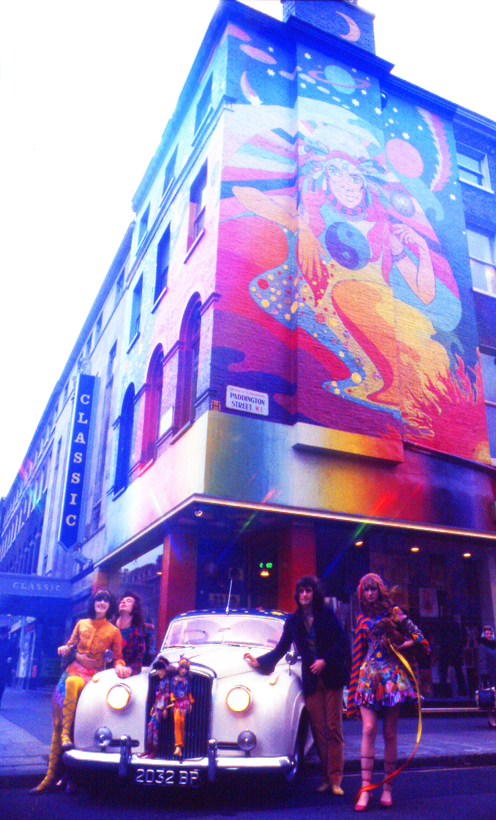“We were young, rich and beautiful, and the tide—we thought—was turning in our favor. We were going to change everything, of course, but mostly we were going to change the rules.” This quote from Marianne Faithfull is posted at the entrance to “Beautiful People: The Boutique in 1960s Counterculture,” a new exhibition at London’s Fashion and Textile Museum. In a decade that saw meditation going mainstream and the fashionable world racing helter-skelter toward higher consciousness—often with the help of this or that substance—the boutiques of Chelsea were the dress-up box of the moment.
This show re-creates eight of the most influential: Hung on You, Granny Takes a Trip, Biba, Apple Boutique, Apple Tailoring, Mr. Fish, Dandie Fashions, and Quorum. Not just your average shops, the Chelsea boutiques were the stylish expression of their owners, some of London’s most creative minds. In fact, they were more like salons, places to hang out for hours, or days if you were cool enough. Each had its own clique and identity.

Michael Rainey’s Hung on You married Savile Row–quality tailoring and modern dandy styles at 430 Kings Road. Just down the street, at 488, was its greatest competition, Granny Takes a Trip, which started off as a vintage-clothing shop but quickly began producing its own collections. Of course, it was not just Granny who was taking a trip. “Spirituality was really the most important thing,” says Jane Ormsby Gore, the interior decorator and former wife of Rainey. But she also remembers “a rather smart cocktail party in Pont Street, and all of the drinks were laced with acid.”
Toss a pebble into this pool and the ripple effect is astonishing. Everyone was part of the scene. The logo for Biba, founded by Barbara Hulanicki, was designed by Anthony Little of Osborne & Little (as was the window of Hung on You). Biba’s ingenious mail-order catalogues were shot by Sarah Moon and Helmut Newton.

At the Club Dell’Aretusa, the owner’s daughter swears, a certain David Jones (who later changed his surname to Bowie) was the receptionist. And over the road at the Quorum boutique, 21-year-old David Gilmour’s day job was as delivery driver for the brilliant designer Ossie Clark, whose bias-cut chiffon dresses, printed with his wife Celia Birtwell’s designs, somehow made it O.K. for girls to walk around bra-less in semi-transparent dresses and blouses.
The Beatles’ own foray into retail, opened in 1967 and called the Apple Boutique, was highly conceptual and a business disaster. The design side was entrusted to the much-admired Dutch collective known as the Fool, who were previously commissioned to design an album cover for Sgt. Pepper’s Lonely Hearts Club Band (which ultimately wasn’t used). While footfall was high, sales were low, as the clothes were fantastical and extremely expensive. The band closed the store and bought Dandie Fashions, renaming it Apple Tailoring.
Trying to pin down the moment when everything changed is one of the great puzzles of history. For some, the 1966 death of the Irish socialite Tara Browne marked the end of the 1960s. By 1968, Lennon had abandoned psychedelia, moved to the exquisite Tittenhurst Park with Yoko Ono, and started to dress all in white. Also in ’68, Rainey closed Hung on You.

By 1971, the Beatles had broken up. The Rolling Stones, on the advice of Prince Rupert Loewenstein, were living as tax exiles in the South of France.
Of the boutiques covered in this exhibition, one of the last to close was Biba, in 1975. Its designs were still impeccable, but shoplifting had become a problem. Vivienne Westwood and Malcolm McLaren eventually took over 430, which is the story of another era entirely. The area surrounding the store is now home to a clutch of rather shabby charity shops, where, if you’re very lucky, you may just find a little treasure with a connection to the neighborhood’s dizzying past. —Sarah Hyde


 Discover
Discover